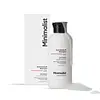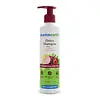What's inside
What's inside
 Key Ingredients
Key Ingredients

 Benefits
Benefits

 Concerns
Concerns

 Ingredients Side-by-side
Ingredients Side-by-side

Water
Skin ConditioningDisodium Laureth Sulfosuccinate
CleansingGlycerin
HumectantCocamide Mea
EmulsifyingDisodium Cocoyl Glutamate
CleansingCocamidopropyl Betaine
CleansingGlycol Stearate
EmollientSodium Lauryl Sulfoacetate
CleansingDimethiconol
EmollientSodium Lauroyl Sarcosinate
CleansingUndecylenoyl Glycine
CleansingCapryloyl Glycine
CleansingSodium Cocoyl Isethionate
CleansingPolyquaternium-7
Tocopheryl Acetate
AntioxidantSalicylic Acid
MaskingSodium Cocoate
CleansingPiroctone Olamine
PreservativeClimbazole
AntimicrobialAcrylates Copolymer
Polyquaternium-10
Carbomer
Emulsion StabilisingHydroxypropyl Methylcellulose
Emulsion StabilisingPEG-45m
HumectantPhenoxyethanol
PreservativeSodium Glutamate
MaskingSodium Hydroxide
BufferingTrisodium Ethylenediamine Disuccinate
Tea-Dodecylbenzenesulfonate
CleansingEthylhexylglycerin
Skin ConditioningWater, Disodium Laureth Sulfosuccinate, Glycerin, Cocamide Mea, Disodium Cocoyl Glutamate, Cocamidopropyl Betaine, Glycol Stearate, Sodium Lauryl Sulfoacetate, Dimethiconol, Sodium Lauroyl Sarcosinate, Undecylenoyl Glycine, Capryloyl Glycine, Sodium Cocoyl Isethionate, Polyquaternium-7, Tocopheryl Acetate, Salicylic Acid, Sodium Cocoate, Piroctone Olamine, Climbazole, Acrylates Copolymer, Polyquaternium-10, Carbomer, Hydroxypropyl Methylcellulose, PEG-45m, Phenoxyethanol, Sodium Glutamate, Sodium Hydroxide, Trisodium Ethylenediamine Disuccinate, Tea-Dodecylbenzenesulfonate, Ethylhexylglycerin
Water
Skin ConditioningCaprylyl/Capryl Glucoside
CleansingSodium Methyl Cocoyl Taurate
CleansingCocamidopropyl Betaine
CleansingSodium Cocoamphoacetate
CleansingSodium Lauroyl Sarcosinate
CleansingGlycerin
HumectantXanthan Gum
EmulsifyingSalmon Oil
Skin ConditioningKeratin
Skin ConditioningGlyceryl Stearate
EmollientPanthenol
Skin ConditioningPolyquaternium-73
Polyquaternium-10
Tocopherol
AntioxidantSodium PCA
HumectantPotassium Sorbate
PreservativeSodium Gluconate
Skin ConditioningPhenoxyethanol
PreservativeWater, Caprylyl/Capryl Glucoside, Sodium Methyl Cocoyl Taurate, Cocamidopropyl Betaine, Sodium Cocoamphoacetate, Sodium Lauroyl Sarcosinate, Glycerin, Xanthan Gum, Salmon Oil, Keratin, Glyceryl Stearate, Panthenol, Polyquaternium-73, Polyquaternium-10, Tocopherol, Sodium PCA, Potassium Sorbate, Sodium Gluconate, Phenoxyethanol
Ingredients Explained
These ingredients are found in both products.
Ingredients higher up in an ingredient list are typically present in a larger amount.
Cocamidopropyl Betaine is a fatty acid created by mixing similar compounds in coconut oil and dimethylaminopropylamine, a compound with two amino groups.
This ingredient is a surfactant and cleanser. It helps gather the dirt, pollutants, and other impurities in your skin to be washed away. It also helps thicken a product and make the texture more creamy.
Being created from coconut oil means Cocamidopropyl Betaine is hydrating for the skin.
While Cocamidopropyl Betaine was believed to be an allergen, a study from 2012 disproved this. It found two compounds in unpure Cocamidopropyl Betaine to be the irritants: aminoamide and 3-dimethylaminopropylamine. High-grade and pure Cocamidopropyl Betaine did not induce allergic reactions during this study.
Learn more about Cocamidopropyl BetaineGlycerin is already naturally found in your skin. It helps moisturize and protect your skin.
A study from 2016 found glycerin to be more effective as a humectant than AHAs and hyaluronic acid.
As a humectant, it helps the skin stay hydrated by pulling moisture to your skin. The low molecular weight of glycerin allows it to pull moisture into the deeper layers of your skin.
Hydrated skin improves your skin barrier; Your skin barrier helps protect against irritants and bacteria.
Glycerin has also been found to have antimicrobial and antiviral properties. Due to these properties, glycerin is often used in wound and burn treatments.
In cosmetics, glycerin is usually derived from plants such as soybean or palm. However, it can also be sourced from animals, such as tallow or animal fat.
This ingredient is organic, colorless, odorless, and non-toxic.
Glycerin is the name for this ingredient in American English. British English uses Glycerol/Glycerine.
Learn more about GlycerinPhenoxyethanol is a preservative that has germicide, antimicrobial, and aromatic properties. Studies show that phenoxyethanol can prevent microbial growth. By itself, it has a scent that is similar to that of a rose.
It's often used in formulations along with Caprylyl Glycol to preserve the shelf life of products.
Polyquaternium-10 is an ammonium salt of hydroxyethylcellulose. It is a white and granular powder used as a film-former and anti-static agent.
This ingredient is commonly found in hair conditioning products. According to a manufacturer, its positive charge makes it great for absorbing hair proteins. The manufacturer also states this ingredient helps with curl retention.
For haircare friends: this ingredient is not a silicone.
Learn more about Polyquaternium-10Sodium Lauroyl Sarcosinate is a cleansing agent and emulsifier. It is a surfactant derived from sarcosine, and a common source is coconut oil.
As a surfactant, Sodium Lauroyl Sarcosinate helps lift dirts, oil, and other molecules to be washed away. In leave-on products, this ingredient is used as an emulsifier. Emulsifier help prevent ingredients such as oils and waters from separating.
Sodium Lauroyl Sarcosinate is also commonly found as a foaming agent in shampoo, toothpaste, and shaving foam. It is amphiphilic, meaning it loves both water and fats.
Learn more about Sodium Lauroyl SarcosinateWater. It's the most common cosmetic ingredient of all. You'll usually see it at the top of ingredient lists, meaning that it makes up the largest part of the product.
So why is it so popular? Water most often acts as a solvent - this means that it helps dissolve other ingredients into the formulation.
You'll also recognize water as that liquid we all need to stay alive. If you see this, drink a glass of water. Stay hydrated!
Learn more about Water